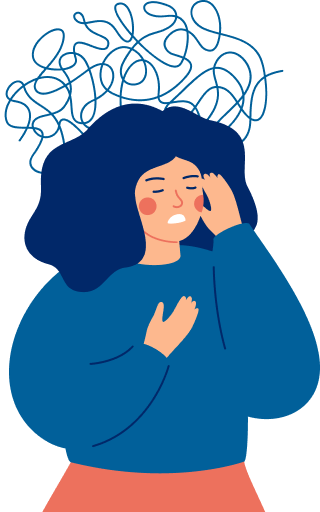Around 5% of Australians experience a panic disorder in their lifetime
Panic attacks are sudden episodes of intense fear, and can be frightening and debilitating.

Around 5% of Australians experience a panic disorder in their lifetime
Panic attacks are sudden episodes of intense fear, and can be frightening and debilitating.


Panic attacks are sudden episodes of intense fear or discomfort that can be accompanied by physical symptoms such as rapid heartbeat, sweating, trembling, chest pain, and shortness of breath. Panic attacks can be frightening and debilitating, causing individuals to avoid situations or places that they associate with the attack.
At Guiding Light Psychology, we understand how disruptive and distressing panic attacks can be for individuals. Our therapists use evidence-based techniques such as Cognitive Behavioral Therapy (CBT) and Exposure Therapy to help individuals manage their panic attacks and reduce their frequency and intensity. Through therapy, individuals can learn coping mechanisms and relaxation techniques to help them manage their symptoms and prevent panic attacks from occurring.

We believe that it’s essential for individuals experiencing panic attacks to seek treatment and support. Panic attacks can significantly impact an individual’s daily life, relationships, and overall well-being, and can lead to other mental health conditions such as agoraphobia or depression. With the right treatment and support, individuals can learn to manage their symptoms and improve their quality of life.
You can easily get in touch with us by calling (02) 7252 3418 or by sending an email to info@guidinglightpsychology.com.au. Our friendly team is always ready to assist you with any questions or concerns you may have about our services.

What causes panic attacks?
-
Panic attacks can be caused by a variety of factors, including stress, trauma, genetics, and medical conditions such as heart disease or thyroid problems. In some cases, panic attacks may be triggered by specific situations or stimuli, such as social situations or enclosed spaces.
How can I tell if I'm having a panic attack?
+
Panic attacks are typically characterised by sudden and intense feelings of fear or discomfort, accompanied by physical symptoms such as rapid heartbeat, sweating, trembling, chest pain, and shortness of breath. Other symptoms may include nausea, dizziness, tingling sensations, and a feeling of being detached from reality. If you experience these symptoms, especially in situations that you associate with panic attacks, you may be having a panic attack.
Can panic attacks be treated?
+
Yes, panic attacks can be treated with a variety of therapies, including Cognitive Behavioral Therapy (CBT), Exposure Therapy, and medication. In therapy, individuals can learn coping mechanisms and relaxation techniques to help them manage their symptoms and prevent panic attacks from occurring. With the right treatment and support, individuals can learn to manage their panic attacks and improve their quality of life.